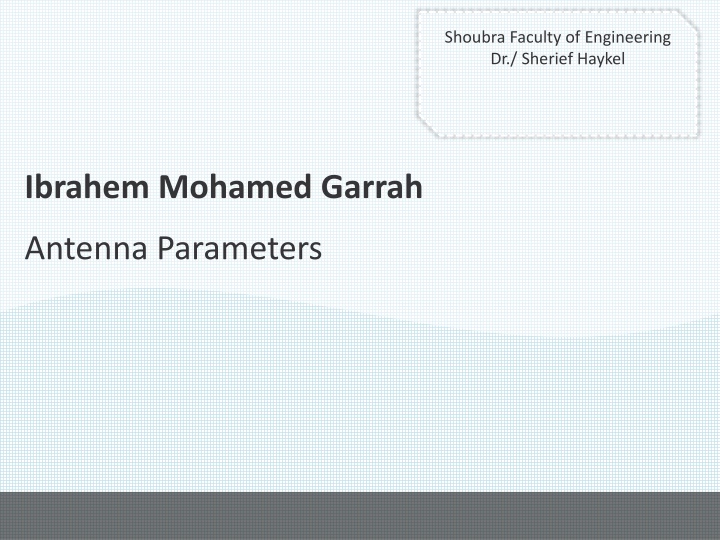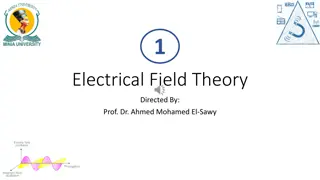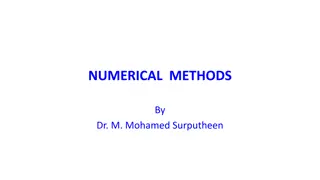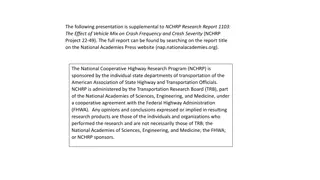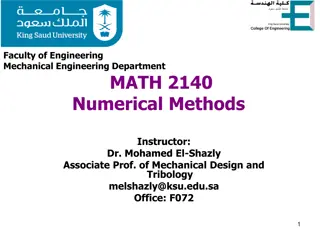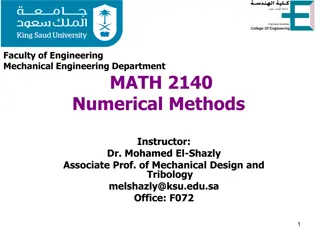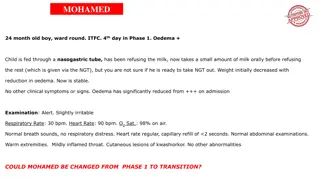Ibrahem Mohamed Garrah
Antenna parameters and radiation patterns play crucial roles in the performance of antennas. The radiation pattern defines how power is radiated in various directions, while antenna directivity measures how directional the radiation pattern is. Different types of antennas, such as isotropic, omnidirectional, and highly directional antennas, exhibit varying radiation patterns. Understanding these concepts is essential for designing efficient communication systems. Explore the significance of radiation intensity, directivity, and effective area in antenna design to optimize signal reception and transmission.
Uploaded on Mar 07, 2025 | 0 Views
Download Presentation

Please find below an Image/Link to download the presentation.
The content on the website is provided AS IS for your information and personal use only. It may not be sold, licensed, or shared on other websites without obtaining consent from the author.If you encounter any issues during the download, it is possible that the publisher has removed the file from their server.
You are allowed to download the files provided on this website for personal or commercial use, subject to the condition that they are used lawfully. All files are the property of their respective owners.
The content on the website is provided AS IS for your information and personal use only. It may not be sold, licensed, or shared on other websites without obtaining consent from the author.
E N D
Presentation Transcript
Shoubra Faculty of Engineering Dr./ Sherief Haykel Ibrahem Mohamed Garrah Antenna Parameters
Radiation Pattern A radiation pattern defines the variation of the power radiated by an antenna as a function of the direction away from the antenna. A pattern is "isotropic" if the radiation pattern is the same in all directions. Antennas with isotropic radiation patterns don't exist in practice, but are sometimes discussed as a means of comparison with real antennas.
Some antennas may also be described as "omnidirectional", which for an actual antenna means that the radiation pattern is isotropic in a single plane Examples of omnidirectional antennas include the dipole antenna and the slot antenna. The third category of antennas are "directional", which do not have a symmetry in the radiation pattern. These antennas typically have a single peak direction in the radiation pattern; this is the direction where the bulk of the radiated power travels.
examples of antennas with highly directional radiation patterns include the dish antenna and the slotted waveguide antenna. An example of a highly directional radiation pattern (from a dish antenna) is shown in Figure.
Radiation intensity of an antenna is defined as the power radiated from an antenna in a given direction per unit solid angle. It is expressed in watt per stradian (W/sr). The average radiation intensity (Uavg) can be written as
Directivity It is a measure of how 'directional' an antenna's radiation pattern is. An antenna that radiates equally in all directions would have effectively zero directionality, and the directivity of this type of antenna would be 1 (or 0 dB). The Directivity of an antenna is defined as the ratio of radiation intensity in a given direction from the antenna to the radiation intensity averaged over all directions.
Antennas for cell phones should have a low directivity because the signal can come from any direction, and the antenna should pick it up. In contrast, satellite dish antennas have a very high directivity, because they are to receive signals from a fixed direction. As an example, if you get a directTV dish, they will tell you where to point it such that the antenna will receive the signal. Effective Area or effective arpeture (Ae) describes how much power is captured from a given plane wave.
Antenna Efficiency The efficiency of an antenna is a ratio of the power delivered to the antenna relative to the power radiated from the antenna. The total efficiency of an antenna is the radiation efficiency multiplied by the impedance mismatch loss of the antenna, when connected to a transmission line or receiver (radio or transmitter)
Antenna Gain The term Antenna Gain describes how much power is transmitted in the direction of peak radiation to that of an isotropic source. A transmitting antenna with a gain of 3 dB means that the power received far from the antenna will be 3 dB higher (twice as much) than what would be received from a lossless isotropic antenna with the same input power. Antenna Gain (G) can be related to directivity (D) and antenna efficiency by:
Beamwidths and Sidelobe Levels The main beam is the region around the direction of maximum radiation (usually the region that is within 3 dB of the peak of the main beam). The sidelobes are smaller beams that are away from the main beam. These sidelobes are usually radiation in undesired directions which can never be completely eliminated. The Half Power Beamwidth (HPBW) is the angular separation in which the magnitude of the radiation pattern decrease by 50% (or -3 dB) from the peak of the main beam. Null to Null Beamwidth. This is the angular separation from which the magnitude of the radiation pattern decreases to zero. Sidelobe Level is the maximum value of the sidelobes (away from the main beam).
